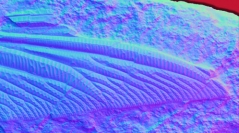

 Geodiversitas
45 (17) - Pages 479-496
Geodiversitas
45 (17) - Pages 479-496The systematics of the Triadophlebiomorpha, a group of often large-sized stem-Odonata, essentially Triassic, is reconsidered based on new data on some of the known species and on new material from the Molteno Formation (South Africa). New data on Reisia gelasii (Reis, 1909) (Anisian; Muschelkalk basin, Germany) and ‘Triadotypus’ guillaumei Grauvovel & Laurentiaux, 1952 (Anisian; Grès à Voltzia, France) allowed reconsidering the delimitation of the corresponding genera, Reisia Handlirsch, 1912 and Triadotypus Grauvogel & Laurentiaux, 1952, the latter regarded as a junior synonym of the former. Thanks to its pristine preservation of the wing three-dimensional structure, the material of Piroutetia liasina Meunier, 1907, re-illustrated, provides further insights on wing venation homologies in the group. These new data, coupled with new ones on known and new material from Molteno (Carnian; Karoo Basin, South Africa), led us to corroborate the placement of Triassologus biseriatus Riek, 1976 to the Triadophlebiomorpha, and to recognize ‘Reisia’ rieki Deregnaucourt, Wappler, Anderson & Béthoux, 2017 as its junior synonym. In turn, it is argued that the sub-contemporaneous species Iverya aveyri Béthoux & Beattie, 2010, from Australia, is to be assigned to Triassologus Riek, 1976 (and the genus Iverya Béthoux & Beattie, 2010 considered its junior synonym), further emphasizing similarities between South African and Australian Triassic insect faunas. A subset of the Triadophlebiomorpha possesses a CuP+AA stem splitting into CuA and CuP+AA (as opposed to Cu and AA). This trait is present in Nototriadophlebia pritykinae n. gen., n. sp., an addition to the Triadophlebiomorpha from Molteno.
Full dataset of the article available on: https://doi.org/10.48579/PRO/FZEFME
Fossil insect, Triassic, revision, RTI, Molteno, new synonyms, new combinations, new genus, new species